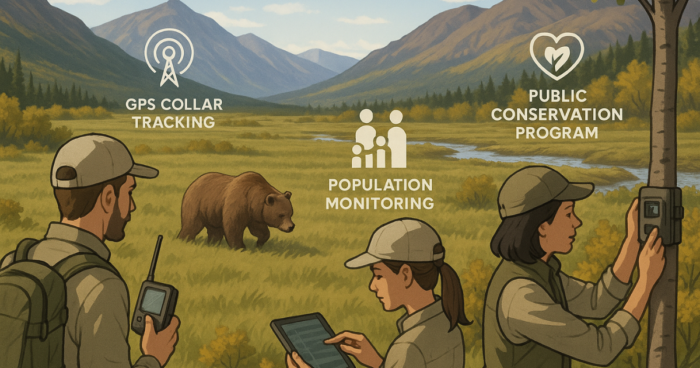Grizzly bear research projects in Alaska combine efforts from citizen science and biologist-led studies to improve understanding and conservation. As one of Alaska’s most iconic species, the grizzly bear plays a vital role in the ecosystem. Monitoring its behavior, population trends, and responses to human activity provides essential insight for wildlife management. Through collaborative research initiatives, both professional scientists and local communities contribute to meaningful wildlife monitoring. This synergy strengthens conservation science and helps protect these remarkable animals for future generations.
Overview of Grizzly Bear Monitoring Programs in Alaska
Grizzly bear monitoring programs in Alaska are at the forefront of wildlife research, supporting critical efforts to track population trends, migration routes, and habitat use. These programs are typically coordinated by government agencies such as the Alaska Department of Fish and Game (ADF&G), along with national parks and university-led initiatives.
Many Alaska wildlife tracking projects utilize advanced tools like satellite telemetry and motion-activated camera traps to monitor bear movement. These technologies allow scientists to study seasonal patterns, feeding behavior, and human-wildlife overlap without disturbing the animals directly.
Biologist-led bear studies ensure scientific rigor and provide long-term data that shape wildlife policy. Field researchers collect genetic samples, assess reproductive health, and evaluate habitat quality, efforts essential for effective population assessment and long-term species viability.
Role of Citizen Science and Community Involvement
Citizen science in wildlife research plays an increasingly important role in grizzly bear studies across Alaska. Volunteers help researchers by recording sightings, collecting bear hair samples for DNA analysis, and maintaining remote camera stations. This expanded data collection capacity enhances scientific outcomes and fosters a culture of conservation.
Community involvement in bear research builds stronger local partnerships and deepens public appreciation for Alaska’s wildlife. Through volunteer engagement and training workshops, residents gain firsthand experience with conservation efforts. Their contributions support data validation while increasing public knowledge and ownership of ecological issues.
Research Techniques: Tracking, Surveying, and Data Collection
![]()
Modern data collection methods for bear behavior include a combination of high-tech and field-based tools. One of the most reliable systems is the use of GPS collars in bear research, which provides real-time location data to map migration patterns and core habitat zones.
Alongside this, researchers conduct grizzly bear population surveys using aerial observations, genetic sampling, and den site counts. These approaches provide insight into population density, cub survival rates, and reproductive trends over time.
Field teams also rely on behavioral observation, noting feeding habits, social interactions, and reactions to environmental change. This information feeds into broader statistical analysis, helping scientists predict how bears may adapt to shifting climates and human presence.
Conservation Insights and Human Impact Studies
Conservation science and grizzly bears go hand-in-hand, as research helps guide policies on land use, hunting regulations, and protected area management. Key findings from Alaska studies have influenced national conservation strategies and habitat designations.
Through human impact studies on Alaskan bears, researchers investigate the effects of road construction, tourism, and resource extraction on bear behavior and health. These studies help identify patterns of habitat fragmentation, displacement, and increased human-wildlife conflict, enabling agencies to implement informed mitigation strategies.
Species-Specific Findings: Brown Bear vs Grizzly Bear
Though often grouped together, research has uncovered meaningful differences between brown and grizzly bears. Variations in diet, range, and temperament reflect the species’ ecology. Coastal brown bears, for example, benefit from rich salmon resources, leading to different social and foraging behaviors than their inland grizzly counterparts.
These studies reveal how behavioral variation and adaptation mechanisms influence interactions with humans and other wildlife.
For a deeper dive into the differences between these bears, see our pillar article on brown bear vs grizzly bear.
Conclusion
Grizzly bear research projects in Alaska reflect the power of collaboration between professional scientists and dedicated citizen volunteers. These efforts not only expand our knowledge of bear ecology but also strengthen conservation outcomes. By combining cutting-edge technology, local engagement, and long-term observation, researchers are helping ensure the survival of Alaska’s iconic bears.
To further understand species differences and how they affect research, visit our guide on brown bear vs grizzly bear.


